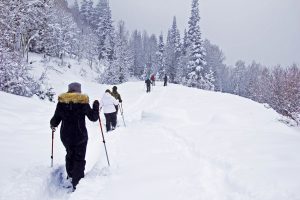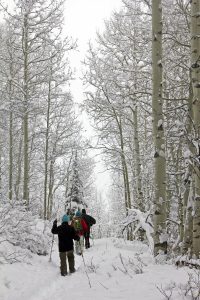Delicate plate-like crystals of ice cover the snow. Your knowledgeable guide from All Seasons Adventures informs you of the hoar frost that formed the previous evening. You realize the term is familiar but cruising by on skis the intricate beauty of winter was easily overlooked. Stepping out of ski boots and into snowshoes is an incredible way to slow down, unwind and see the mountains surrounding Park City. A Naturalist’s perspective on snowshoeing can open your eyes to a whole different world.
Abundant resident wildlife take advantage of the biodiversity that change in elevation and slope aspect offers. Snowshoeing quietly through the forest it is not uncommon to see moose, deer, elk and a variety of small mammals and birds. The ecosystems are diverse with gnarled, now leafless slow-growing Gamble Oak (Quercus gambelii) producing acorns that are essential forage for wintering wildlife. Deciduous white barked Quaking Aspen (Populus tremulodies) loving referred to as “quakies” have lost their leaves as well, however, coniferous trees such as White Fir (Abies concolour), Subalpine Fir (Abies lasiocarpa), Douglas Fir (Pseudotsuga menziesii), Lodgepole Pine (Pinus contorta), Engelmann Spruce (Picea engelmannii) offer protection for wintering Dark Eyed Juncos (Junco hyemalis) and Chickadeees (Poecile atricapillus, gambeli). Careful inspection of the forest tops may yield the small Northern Saw-Whet Owl (Aegolius acadicus) or a hungry bark eating porcupine (Erethizon dorsatum).
Often heard before seen the small, loquacious Pine Squirrel (Tamiasciurus hudsonicus) rely on the cones produced by spruce trees for winter forage. Look closely at the base of conifers for piles of deconstructed cones and with patients spot the lively forest dweller. Snowshoe hares (Lepus americanus) are more difficult to spot as they are most active at night when they follow well-worn paths in their search for food. Their large feet help keep them atop the snow leaving behind large distinctive tracks. Chances are good to spot them on a full moon snowshoe adventure but keep in mind these hares demonstrate a seasonal molting with their dark coat becoming pure snow white in winter.
 Larger mammals are often seen feeding on the leaf buds of trees and during hard winters will eat bark as well. Elk (Cervus elaphus), Mule Deer (Odocoileus hemionus) and Moose (Acles acles) are common forest dwellers. Moose, being the largest of the deer family, often have males weighing in at almost 1,000 pounds. Males of all three species carry impressive antlers that are shed annually and begin to regrow in late winter early spring.
Larger mammals are often seen feeding on the leaf buds of trees and during hard winters will eat bark as well. Elk (Cervus elaphus), Mule Deer (Odocoileus hemionus) and Moose (Acles acles) are common forest dwellers. Moose, being the largest of the deer family, often have males weighing in at almost 1,000 pounds. Males of all three species carry impressive antlers that are shed annually and begin to regrow in late winter early spring.
The team at All Seasons Adventures would love to share a snow shoeing experience in the snow covered forests of Utah with your family. It is an unforgettable experience. The quiet meadows and forested hill-sides take on a unique stillness that the bustle of summer insects and migratory birds disrupt. Take time to step out onto freshly fallen snow and see the forest in a whole different seasonal perspective. Please call or email with any questions.